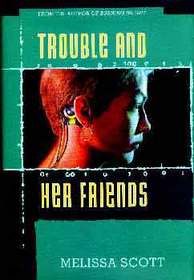
Trouble and Her Friends
Melissa Scott
379 pages
published in 1994
Trouble and Her Friends is the tenth book I’ve read in my Year of Reading Women project and the first and only cyberpunk novel in the bunch. It’s a book I’ve long wanted to read, having heard nothing but praise for it over the years and seeing it compared to e.g. Pat Cadigan’s cyberpunk novels. As I started reading it, there were two minor things that disappointed me: the first was the publication date, 1994, much later than I though, the second was the tendency of the covers to flake, something it has in common with other Tor books of that period. I’d always assumed Trouble and Her Friends had been published in the mid-eighties; certainly the setting is very eighties.
This matters because it means that not only is its future dated now, but it was already obsolete when it was first published. Trouble and Her Friends‘s vision of cyberspace is essentially an eighties one, where it’s important but largely unused by regular people, divided into discrete blocks owned by huge multinationals and hidden behind ICE (Intrusion Countermeasures (Electronic)) to ward off hackers, who seem to be the only people behind corporate drones to use cyberspace. It’s obviously inspired by the BBS scenes of the eighties and indeed the main hacker hangout is called the BBS. Yet 1994 was the year the internet fully broke into the public consciousness, when it should’ve become clear that it’s the openness of the internet and interaction with other people on it that are its greatest strengths, far removed from the lonely adventures of isolated hackers battling in virtual reality with faceless corporate ICE software that most cyberpunk, including Trouble and Her Friends, offers — it’s probably no coincidence that it largely died as a subgenre in the mid nineties. What saves Trouble and Her Friends from complete obsolescence can be summed up in one word: politics.
Most cyberpunk writers sort of took their politics from Neuromancer, which never was much concerned with plausible future politics (indeed, science fiction as a whole has always been a bit weak in this regard). So you got a lot of adolescent posturing of the heroic hacking underground versus the big bad megacorps out to rule the world. What Trouble and Her Friends does that few other cyberpunk novels do is to look at the internal politics of that hacking underground itself. And by doing so Melissa Scott is the only cyberpunk author that actually understood and anticipated the dynamics of online groups, of how even in groups that define themselves as outsiders there can be people who are outside the group as well, because for one reason or another they are different from the dominating members of a given group. Not a new dynamic of course, as any veteran of a socialist or anarchist splinter group can confirm. Even in progressive groups race, gender and sexuality play a role, but most cyberpunk authors assumed that in the bodiless worlds of cyberspace these things would no longer matter. Melissa Scott was clever enough to know that this is naive at best.
Her heroines — Trouble and Cerise — therefore because they are female, lesbian and use the brainworm implant disdained by the overwhelmingly male straight old programmable elite, are low on the totem pole in the semi-legal hacking scene and hence vulnerable once new US legislation outlaws hacking outright. Trouble flees and moves deeper underground, while Cerise goes legit but is still vulnerable because of her questionable past, which her immediate superior at the company she works for uses to manipulate her. Trouble herself is not safe either, hiding behind an alias that if it would come to the wrong people’s attention would not last long.
And then a new Trouble appears on the ‘net, who is not just doing all sorts of highly illegal things, but boasting about it as well. Which is enough to bring Trouble out of retirement and Cerise back to her old life to bring this newby to heel. The old gunslingers return to fight it out one more time with the cocky new bravo….
Despite Trouble and Her Friends‘s outdated even at time of publication view of what cyberspace would look like, what Melissa Scott was better in than even many respectable non-fiction authors writing about the internet at the time, in that she saw that cyberspace would not stay an unregulated jungle forever. The plot of the novel is largely driven by the introduction of harsh, bad law that made most of what Trouble and her friends did on the net illegal overnight, something a lot of Wired were convinced off would never happen in real life, despite warning signs like Operation Sundevil back in 1990.
This combination of realistic gender and sexual politics and being clueful enough to realise that yes virginia, governments can regulate cyberspace make Trouble and Her Friends worth reading. It helps that Scott can write well too, which keeps you reading though the plot is a bit thin.